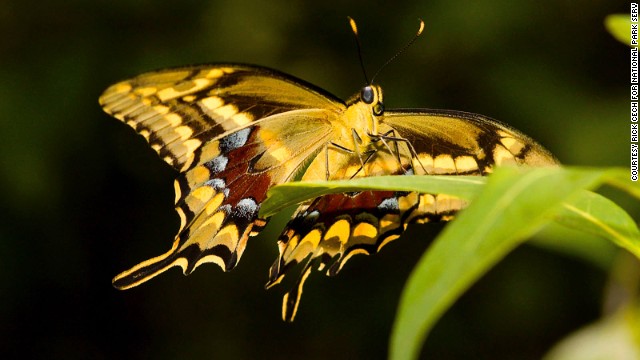- Back to Home »
- Butterfly species barely hanging on

- Researchers are caring for caterpillars of endangered species
- The Schaus swallowtail butterfly has declined in numbers
- It lives only in a small area within South Florida, mostly on small islands
- University of Florida entomologist is caring for caterpillars
(CNN) -- At his version of an ICU unit, Jaret Daniels pays extraordinary attention to his young charges.
Each of the creatures is kept in its own plastic cup, isolated to prevent the spread of disease.
Not just any food will do. In their climate-controlled environment, the Schaus swallowtail caterpillars munch voraciously on wild lime.
Daniels, an entomologist at the University of Florida, is raising seven immature butterflies belonging to a species that is critically endangered and just "hanging on."
The pressure, Daniels said, is enough to keep him up at night.
He and others are trying to save an insect that is on the brink of extinction and in need of human intervention.
The U.S. Fish and Wildlife Service issued an emergency directive in 2012 to collect females in Biscayne National Park and raise their eggs.
While no females were collected last year, officials announced this week that an adult female was snared on the park's Elliott Key last month, along with six larvae. The female produced one egg.
Federal and state officials say the Schaus' hopes might depend on a breeding program that may help safeguard a portion of the remaining population.
"I know what I am doing," Daniels told CNN on Tuesday. "I am going to do the best that I can do."
The Schaus swallowtail, contained to a relatively small area in southeastern Florida, in 1976 was listed under the Endangered Species Act as threatened. It reached the endangered status eight years later.
The colorful butterfly's numbers have dropped precipitously over the decades. Captive breeding was tried in the 1980s and 1990s, boosting the Schaus numbers for a time.
That didn't last long.
During a 2011 survey, there were only 41 sightings, mostly on Elliott Key. That number dropped to four last year.
Habitat destruction, drought, hurricanes and pesticide use outside Biscayne National Park were likely contributing factors to the insect's demise, experts say.
But a glimmer of hope broke out this spring in the park south of Miami when seven adult butterflies were spotted.
Marissa Streifel, a research technician, collected the adult female on May 21. Daniels had a hard time hearing her during a static-laden phone call.
"I recall her saying, 'We got one. Woo-hoo!' " Daniels said.
Streifel used a net to capture the female, a challenge in the dense hammock vegetation.
"If you know how to use it well, the chance of injuring the butterfly is extremely low," Daniels said.
After four days in an enclosure, the female was released. Because of heavy rain and poor weather conditions, she produced only one viable egg, the size of the head of a pin. It is one of the larvae in the University of Florida laboratory in Gainesville.
But in a razor-thin scenario, that's certainly better than none.
Schaus swallowtails generally live only two weeks in the wild, perhaps 30 to 40 days in captivity. They reproduce only once a year.
After a 10- to 11-month pupa stage, butterflies will emerge bearing black-brown wings with yellow markings and a broad rusty patch beneath the hind wing. They feature aquamarine spots.
Experts hope all seven in the lab will survive to adulthood.
Elsa Alvear, chief of resource management at Biscayne National Park, told CNN they "may make a difference between extinction and nonextinction."
"This species used to be found in a lot of places in South Florida and the Keys," she said. "We want to get numbers up and see it restored to more than just one island."
The search for more females is continuing this summer. Researchers hope they can net a female that will produce a couple hundred eggs, providing a huge boost to the desperate situation.
"If she is productive, you can ramp up that population pretty quickly," said Daniels.
Of the seven butterflies, one is in the pupa phase and another is close to it. Once they complete that lengthy stage, they emerge, show their spectacular colors and take flight.
That's expected to take place next spring, unless officials decide to simulate spring rains to bring them out early.
Daniels said he is cautiously optimistic about the latest developments, although the Schaus swallowtail faces daunting challenges. There is no flexibility if weather or other factors turn against the insect.
"Even a minor disturbance can deal a death blow to this organism," Daniels said.
Alvear said volunteers at the national park are helping to plant wild lime and torchwood, both food sources for the Schaus swallowtail.
"It is a beautiful butterfly, and it would be a shame to lose this," she said.







